1、内联方式--即直接在控件内部利用其属性进行设置
<UserControl x:Class="RemoveTextBoxborder.Page"
xmlns="http://schemas.microsoft.com/winfx/2006/xaml/presentation"
xmlns:x="http://schemas.microsoft.com/winfx/2006/xaml"
WIDth="400" Height="300">
<GrID x:name="LayoutRoot" Background="White">
<button Content="button" Height="75" WIDth="125" borderBrush="Green" Foreground="Blue" />
</GrID>
</UserControl>
2、全局方式--在 App.xaml Resources 文件中进行定义
当你在VS2008中创建Silverlight项目中,你会得到一个名叫 "App.xaml"的文件,此文件格式如下:
<Application xmlns="http://schemas.microsoft.com/winfx/2006/xaml/presentation"
xmlns:x="http://schemas.microsoft.com/winfx/2006/xaml"
x:Class="RemoveTextBoxborder.App"
>
<Application.Resources>
</Application.Resources>
</Application>
在此文件中你可以定义自己的样式,定义样式采用如下格式:
<Style x:Key="样式名" targettype="样式所针对的控件类型">
<Setter Property="控件属性名" Value="控件属性值" />
</Style>
在本示例中我们在此文件加入如下样式定义,加入后的App.xaml文件内容如下
<Application xmlns="http://schemas.microsoft.com/winfx/2006/xaml/presentation"
xmlns:x="http://schemas.microsoft.com/winfx/2006/xaml"
x:Class="RemoveTextBoxborder.App"
>
<Application.Resources>
<Style x:Key="buttonStyleOne" targettype="button">
<Setter Property="borderBrush" Value="Green" />
<Setter Property="Foreground" Value="Blue" />
<Setter Property="borderThickness" Value="4,4,4" />
</Style>
<Style x:Key="buttonStyleTwo" targettype="button">
<Setter Property="borderBrush" Value="Blue" />
<Setter Property="Foreground" Value="Green" />
</Style>
</Application.Resources>
</Application>
然后我们在控件的XAML文件中引用所定义的样式
<UserControl x:Class="RemoveTextBoxborder.Page"
xmlns="http://schemas.microsoft.com/winfx/2006/xaml/presentation"
xmlns:x="http://schemas.microsoft.com/winfx/2006/xaml"
WIDth="400" Height="300">
<GrID x:name="LayoutRoot" Background="White">
<button Content="button" Height="75" WIDth="125" Style="{StaticResource buttonStyleOne}" />
</GrID>
</UserControl>
3、在 C#代码中动态设置控件样式
为了在代码中引用此控件,我们必须要为此控件命名,在此我们命名为"Mybutton"
<button x:name="Mybutton" Content="button" Height="75" WIDth="125" />
然后在Page.xaml的code-behind 文件中,在其构造函数中加入如下代码:
Mybutton.Style = Application.Current.Resources["buttonStyle"] as Style;
后台代码如下:
public partial class Page : UserControl
{
public Page()
{
InitializeComponent();
Mybutton.Style = Application.Current.Resources["buttonStyleOne"] as Style;
}
}
Silverlight2中的页面元素的各个组成部分都可以分离出来作为资源的一部分,以方便复用。
比如我们为用户控件添加一个颜色资源:
<UserControl.Resources> <color x:Key="Green">#F722FF00</color></UserControl.Resources>
然后我们需要在定义的按钮和所画的椭圆中使用{StaticResource Keyname}去使用该资源:
<GrID x:name="LayoutRoot" Background="White"><button Height="56" WIDth="128" Content="button" borderThickness="2,2,2"><button.Background><SolIDcolorBrush color="{StaticResource Green}"/></button.Background></button><Ellipse Height="56" HorizontalAlignment="left" margin="64,176,0" VerticalAlignment="top" WIDth="112"><Ellipse.Fill><SolIDcolorBrush color="{StaticResource Green}"/></Ellipse.Fill></Ellipse></GrID>
效果如图:
样式控制
Silverlight2中支持使用样式,样式也是资源的一部分。样式使用Style标签来指定。
下面我们指定了一个针对button类型的样式:
<UserControl.Resources><Style x:Key="buttonStyle1" targettype="button"><Setter Property="Background" Value="#F722FF00" /><Setter Property="Foreground" Value="#FFFF0000"/><Setter Property="padding" Value="3"/><Setter Property="borderThickness" Value="2"/></Style></UserControl.Resources>
然后我们新添加一个button,通过使用与资源使用相同的语法来为新添加的一个button使用该样式:
<GrID x:name="LayoutRoot" Background="White"><Canvas><button WIDth="128" Height="56" Canvas.left="20" Canvas.top="20"Style="{StaticResource buttonStyle1}" Content="button1" /><button WIDth="128" Height="56" Canvas.left="20" Canvas.top="80"Style="{StaticResource buttonStyle1}" Content="button2" /></Canvas></GrID>
最终效果:
@L_502_1@
上面所提到的资源和样式都是写在用户控件中,只能在用户控件的范围内使用。但如果要在整个应用程序中使用,则应该将样式资源定义在Silverlight项目的App.xaml中:
<Applicationxmlns="http://schemas.microsoft.com/winfx/2006/xaml/presentation"xmlns:x="http://schemas.microsoft.com/winfx/2006/xaml"x:Class="StyleSample.App"><Application.Resources><!-- Resources scoped at the Application level should be defined here. --><Style x:Key="buttonStyle1" targettype="button"><Setter Property="Background" Value="#F722FF00" /><Setter Property="Foreground" Value="#FFFF0000"/><Setter Property="padding" Value="3"/><Setter Property="borderThickness" Value="2"/></Style></Application.Resources></Application>
但如果App.xaml中的样式与用户控件中的样式名称一样,用户控件中的样式会覆盖App.xaml中定义的样式。
<UserControlxmlns="http://schemas.microsoft.com/winfx/2006/xaml/presentation"xmlns:x="http://schemas.microsoft.com/winfx/2006/xaml"x:Class="StyleSample.Page"WIDth="640" Height="480"><UserControl.Resources><Style x:Key="buttonStyle1" targettype="button"><Setter Property="Foreground" Value="#FF000000"/></Style></UserControl.Resources><GrID x:name="LayoutRoot" Background="White"><Canvas><button WIDth="128" Height="56" Canvas.left="20" Canvas.top="20"Style="{StaticResource buttonStyle1}" Content="button1" /><button WIDth="128" Height="56" Canvas.left="20" Canvas.top="80"Style="{StaticResource buttonStyle1}" Content="button2" /></Canvas></GrID></UserControl>
效果如下图,可以看到按钮成了白底黑子,而不是App.xaml中的绿底红字。
视觉状态
视觉状态主要是将元素的逻辑与视觉呈现分离开来。它使得页面的换肤功能相对更容易。
理解视觉状态首先需要明白4个概念:部件、视觉状态、状态迁移和状态组。
部件 (Parts)
部件就是控件模板中被命名的元素。程序可以根据该名称定位到这些部件并进行逻辑 *** 作。
比如上面的水印文本框, 水印就是一个部件,在焦点成为文本框时,水印将会消失。 状态 (States)
视觉状态就是控件定义的一系列的状态,如上面水印文本框的Focus和UnFocus。 状态过渡 (Transitions)
状态过渡就是指控件从一个状态过渡到另一个状态,如水印文本框从UnFocus状态过渡到Focus状态。在这其中可以使用Storyboard来定义动画效果。 状态组 (StateGroups)
状态组就是将控件所有的互斥状态房子啊同一组,最终其状态由所有组中的一个状态来共同决定。
比如还是上面的文本框,它有3个状态组:
Common:normal、 MouSEOver、 Disabled
Watermark:Unwatermarked、Watermarked
Focus:UnFocused、Focused
那么文本框的状态就必须从上面三个状态组中取一个值来定义。如没有任何 *** 作在文本框的时候,其状态为normal|Watermarked|UnFocused。 那么,在上面的基础上又引入了视觉状态(VisualStates)和视觉状态组(VisualStateGroups)的概念。
视觉状态(VisualState)
视觉状态就是指当控件处于某一个状态的时候的视觉效果。比如一个按钮在点击之后,他的边框将会变为不同的颜色。 视觉状态组(VisualStateGroups)
视觉状态组包括了互斥的视觉状态和所拥有的视觉状态的过渡。 通过使用视觉状态管理器(visualstatemanager)来管理视觉状态和视觉状态组,可以根据控件的逻辑改变控件的视觉效果。
更多关于视觉状态的信息,请参考 “部件与状态”模式。
下面对视觉状态所产生的XAML代码做简单说明,下面是上面例子中水印文本框中定义的视觉状态管理代码的一部分。
<Style targettype="local:WatermarkedTextBox"xmlns="http://schemas.microsoft.com/winfx/2006/xaml/presentation"xmlns:x="http://schemas.microsoft.com/winfx/2006/xaml"xmlns:local="clr-namespace:System.windows.Controls;assembly=System.windows.Controls.Extended"xmlns:vsm="clr-namespace:System.windows;assembly=System.windows"><Setter Property="Template"><Setter.Value><ControlTemplate targettype="local:WatermarkedTextBox"><GrID x:name="Root" ><vsm:visualstatemanager.VisualStateGroups><vsm:VisualStateGroup x:name="CommonStates"><vsm:VisualStateGroup.Transitions><vsm:VisualTransition GeneratedDuration="0" /></vsm:VisualStateGroup.Transitions><vsm:VisualState x:name="normal" /><vsm:VisualState x:name="MouSEOver" /><vsm:VisualState x:name="Disabled"><Storyboard><DoubleAnimation Storyboard.Targetname="DisabledVisual"
Storyboard.TargetProperty="Opacity" To="0.5" Duration="0" /></Storyboard></vsm:VisualState></vsm:VisualStateGroup><vsm:VisualStateGroup x:name="WatermarkStates"><vsm:VisualStateGroup.Transitions><vsm:VisualTransition GeneratedDuration="0" /></vsm:VisualStateGroup.Transitions><vsm:VisualState x:name="Unwatermarked" /><vsm:VisualState x:name="Watermarked"><Storyboard><DoubleAnimation Storyboard.Targetname="ContentElement"
Storyboard.TargetProperty="Opacity" To="0" Duration="0" /><DoubleAnimation Storyboard.Targetname="Watermark"
Storyboard.TargetProperty="Opacity" To="1" Duration="0" /></Storyboard></vsm:VisualState></vsm:VisualStateGroup><vsm:VisualStateGroup x:name="Focusstates"><vsm:VisualStateGroup.Transitions><vsm:VisualTransition GeneratedDuration="0" /><vsm:VisualTransition To="Focused" GeneratedDuration="0:0:0.1" /></vsm:VisualStateGroup.Transitions><vsm:VisualState x:name="Unfocused" /><vsm:VisualState x:name="Focused"><Storyboard><DoubleAnimation Storyboard.Targetname="ContentElement"
Storyboard.TargetProperty="Opacity" To="1" Duration="0" /><DoubleAnimation Storyboard.Targetname="Watermark"
Storyboard.TargetProperty="Opacity" To="0" Duration="0" /><DoubleAnimation Storyboard.Targetname="FocusVisual"
Storyboard.TargetProperty="Opacity" To="1" Duration="0" /></Storyboard></vsm:VisualState></vsm:VisualStateGroup></vsm:visualstatemanager.VisualStateGroups></GrID></ControlTemplate></Setter.Value></Setter></Style>
来看代码中的视觉状态组为WatermarkStates的这一部分:
<vsm:VisualStateGroup x:name="WatermarkStates"><vsm:VisualStateGroup.Transitions><vsm:VisualTransition GeneratedDuration="0" /></vsm:VisualStateGroup.Transitions><vsm:VisualState x:name="Unwatermarked" /><vsm:VisualState x:name="Watermarked"><Storyboard><DoubleAnimation Storyboard.Targetname="ContentElement"
Storyboard.TargetProperty="Opacity" To="0" Duration="0" /><DoubleAnimation Storyboard.Targetname="Watermark"
Storyboard.TargetProperty="Opacity" To="1" Duration="0" /></Storyboard></vsm:VisualState></vsm:VisualStateGroup>
代码最前面的vsm表示前缀,在Style中以xmlns:vsm="clr-namespace:System.windows;assembly=System.windows"定义,表示所有以vsm开头的XAML语法所指定的属性需要在assembly为System.windows.dll中定义过。
<vsm:VisualTransition GeneratedDuration="0" /> 定义了过渡该状态组的状态之间过渡的时间,这里设置为0,表示立即过渡到另一状态。
<vsm:VisualState x:name="Watermarked"><Storyboard><DoubleAnimation Storyboard.Targetname="ContentElement"
Storyboard.TargetProperty="Opacity" To="0" Duration="0" /><DoubleAnimation Storyboard.Targetname="Watermark"
Storyboard.TargetProperty="Opacity" To="1" Duration="0" /></Storyboard></vsm:VisualState>
Watermarked这个状态就通过Storyboard定义了一个效果,描述了在进入Watermarked状态时,其ContentElement属性文本立即变为透明(因为Duration为0),而Watermark属性则变为不透明。
综上所述可以看到,由于控件的状态需要在不同的状态组中取其互斥的一个值,然后将各个状态组中的目标状态的动画效果综合在一起,引发了在控件状态变化的时候视觉效果也发生了变化。于是我们可以通过设置一个控件模板来定义不同的样式和效果,而轻松的实现换肤功能。
部署
Silverlight项目的部署并不需要.NET Framework的支持,它的实际工作原理是通过http将服务器上silverlight所生成的XAP压缩包发到客户端,由浏览器的silverlight插件去执行这个压缩包而绘制出最终效果。因此其部署就是完全如同Flash一般使用HTML标签中的object,然后定义好XAP包的路径就可以了。
一般来说,一个silverlight项目所编译生成的XAP包在项目文件下的bin的deBUG目录中:
通过在HTML中嵌入以下HTML代码,将其中的source的值改为所指定的XAP文件,就可以运行silverlight程序了。
<object data="data:application/x-silverlight," type="application/x-silverlight-2" wIDth="100%" height="100%"><param name="source" value="AnimationSample.xap"/><param name="onerror" value="onSilverlightError" /><param name="background" value="white" /><param name="minRuntimeVersion" value="2.0.31005.0" /><param name="autoUpgrade" value="true" /><a href="http://go.microsoft.com/fwlink/?linkID=124807" style="text-decoration: none;"><img src="http://go.microsoft.com/fwlink/?linkID=108181" alt="Get Microsoft Silverlight"
style="border-style: none"/></a></object>
注意上面代码中的minRuntimeVersion,他指定了运行程序所必须的最小的silverlight版本。如果不满足此条件,silverlight程序将可能不能正确运行。
而如果需要在IIS中部署silverlight程序的话,则必须要在IIS中的MIME中添加.xaml的解释,如下图。
总结 以上是内存溢出为你收集整理的SilverLigth 学习笔记--控制 Silverlight控件样式全部内容,希望文章能够帮你解决SilverLigth 学习笔记--控制 Silverlight控件样式所遇到的程序开发问题。
如果觉得内存溢出网站内容还不错,欢迎将内存溢出网站推荐给程序员好友。
欢迎分享,转载请注明来源:内存溢出

 微信扫一扫
微信扫一扫
 支付宝扫一扫
支付宝扫一扫
评论列表(0条)